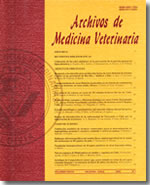Assessment of the effectiveness of electrical stunning method in swine
Main Article Content
Abstract
National and international sanitary legislation state the guidelines that regulate the slaughter of animals for human consumption purposes due to its implications in animal welfare and meat quality. The aim of this study was to evaluate the slaughter in the swine population of a commercial slaughter plant using behavioural and management indicators. A total of 1,341 pigs were monitored. The electrical stunning method was assessed using behavioural indicators in the stunning box (jumps, falls, vocalizations, slips); the signs of consciousness (blink reflex, righting reflex, vocalizations, pain response) and organizational variables (stunning to bleed interval, collapse of the animal, position of the electrodes, application time of the tongs and effectiveness of the stunning procedure). Vocalizations (26.8%) were the behavioural response most commonly found and they were associated to the presence of falls and slips (P < 0.01), making evident certain problems related to the handling of the animals and the infrastructure design. Effective stunning was accomplished in 20.6% of the cases. The righting reflex was positively associated to the presence of all the other signs of consciousness (P < 0.01). The duration of the application of the tongs, the stunning to bleed interval and the electrical specifications were not adequate, evidencing several failures in the standardization of the process. It is strongly recommended to incorporate the behavioral and management indicators to audit routinely the efficiency and animal welfare standards during pig slaughter, as well as promoting training of the staff to guarantee a humane procedure.

